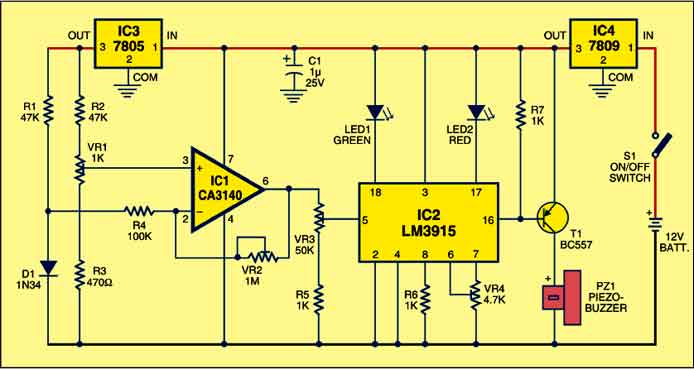 A number of environmental factors including light and temperature affect fish culture. The temperature of water has profound effect because fish cannot breed above or below the critical temperature limits. Temperature between 24°C and 33°C is found to be the best to induce spawning in fishes. This particular temperature range is also necessary for the healthy growth of nursery fish fries (young fishes). Rise of water temperature due to sunlight may adversely affect the fish rearing process. The aquatic probe circuit described here can monitor the temperature of water and indicate the rise in temperature through audio visual indicators.
A number of environmental factors including light and temperature affect fish culture. The temperature of water has profound effect because fish cannot breed above or below the critical temperature limits. Temperature between 24°C and 33°C is found to be the best to induce spawning in fishes. This particular temperature range is also necessary for the healthy growth of nursery fish fries (young fishes). Rise of water temperature due to sunlight may adversely affect the fish rearing process. The aquatic probe circuit described here can monitor the temperature of water and indicate the rise in temperature through audio visual indicators.
Aquatic probe circuit
A readily available signal diode 1N34 is used in the circuit as the temperature sensing probe. The resistance of the diode depends on the temperature in its vicinity. Typically, the diode can generate around 600 mV when a potential difference is applied to its terminals. For each degree centigrade rise in temperature, the diode generates 2mV output voltage. That is, at 5C, it is 10 mV, which rises to 70 mV when the temperature is 35°C. This property is exploited in the circuit to sense the temperature variation in aquarium water. Fig. 1 shows the circuit diagram of the aquatic probe.

Since the output from the diode sensor is too low, a high-gain inverting DC amplifier is used to amplify the voltage. CA3140 (IC1) is the CMOS version op-amp that can operate down to zero-volt output. The highest output available from IC1 is 2.25V less than the input voltage at pin 7. With resistor R4 and VR2, the variation in diode voltage can be amplified to the required level. Resistor R1 restricts current flow through diode D1 and preset VR1 (1-kilo-ohm) sets the input voltage at pin 3. IC3 (7805) provides regulated 5 volts to the inputs of IC1, so that the input voltage is stable for accurate measurement of temperature.
Circuit operation
The output from IC1 is fed to display driver LM3915 (IC2) through preset VR3 (50-kilo-ohm). With careful adjustments, the wiper of VR3 can provide 0-400 millivolts to the input of IC2. The highly sensitive input of IC2 accepts as low as 50 mV if the reference voltage at its pin 7 is adjusted using a variable resistor. To increase the sensitivity of IC2, preset VR4 is connected at one end to ‘reference voltage end’ pin 7 and its wiper is connected to ‘high end’ pin 6 of the internal resistor chain.
When approximately 70 mV is provided to the input of IC2 by adjusting preset VR3, LED1 (green) lights up to indicate that the temperature is approximately 35°C, which is the crossing point. When the input receives 100 mV, LED2 (red) lights up to indicate approximately 50°C. Finally, the buzzer starts beeping if the input receives 130 mV corresponding to a temperature of 65°C.
In short, LEDs and the buzzer remain standby when the temperature of the water is below 35°C (normal). With each step increase of 30 mV in the input (corresponding to 15°C rise in temperature), LEDs and the buzzer become active.
Pin 16 of IC2 is used to drive the piezobuzzer through transistor T1. When pin 16 of IC2 becomes low, T1 conducts to beep the piezobuzzer. Resistor R7 keeps the base of transistor T1 high to avoid false alarm. IC4 provides regulated 9V DC to the circuit.
Construction & testing
Assemble the circuit on a general purpose PCB and enclose in a suitable case. Glass signal diode D1 is immersed in water to sense the temperature of water. Its leads should be coated with enamel paint to avoid shorting in water. Alternatively, enclose the diode in a small glass tube or test tube having sufficient internal space to fit the diode as shown in Fig. 2. Make the sensor assembly waterproof using wax.

Take care while calibrating and setting the circuit. With 5V DC supply to diode D1 and an ambient temperature of about 35°C, D1 generates around 70 mV. Adjust VR3 until the voltage in its wiper increases to 70 mV, so that the input of IC2 (pin 5) receives 70 mV corresponding to the diode output voltage at 35°C. At this stage, green LED1 should turn on. If it doesn’t, adjust VR4 until LED1 just lights up. Immerse the diode in temperature adjusted hot water (35°C) and adjust VR3 and VR4 until green LED1 lights up.
Increase the water temperature to 50°C by adding hot water. Now red LED2 will glow. At this position, the voltage at pin 6 of IC1 will be around 100 mV. When the temperature of water increases further to 65°C, the buzzer starts beeping. After calibration, immerse the diode assembly in the aquarium tank just below the water surface and fix it permanently to avoid floating.
The article was first published in July 2008 and has recently been updated.







